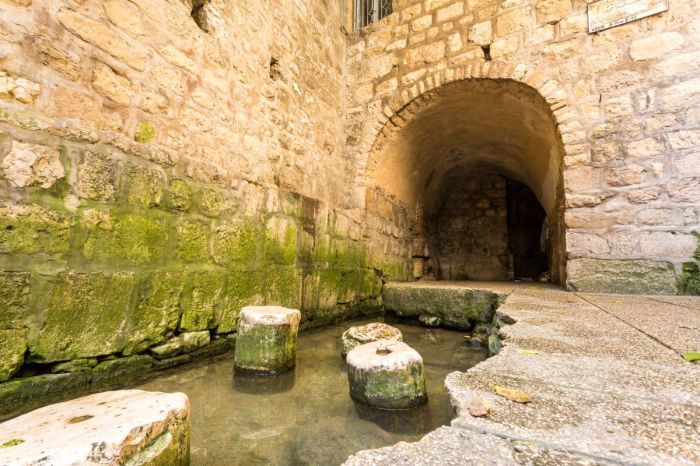
A massive wall unearthed in ancient Jerusalem has been identified as part of the original engineering that formed the Pool of Siloam, the site where Jesus is said to have healed a blind man. Researchers described the discovery as a rare physical link to a location cited in the Gospel of John.
The 39-foot-tall structure, dating to around 2,800 years ago, was part of a sophisticated hydraulic system that helped channel water to the pool from the Gihon Spring.
Archaeologists excavating the site were able to radiocarbon date organic materials embedded in the mortar, including branches and twigs, confirming construction during the First Temple period, The Telegraph reported.
Excavation director Itamar Berko of the Israel Antiquities Authority was quoted as saying that the wall offers “tangible remnants” of a location long known only through scriptural references. He said the discovery was a massive dam wall built during the reigns of kings Joash and Amaziah.
Berko added that the scale and preservation of the structure reveal the engineering capabilities of Jerusalem’s ancient residents.
The dam spans over 26 feet in width and more than 68 feet in length. It was designed to capture and direct rainfall runoff into a central basin, serving both as a water reservoir during drought and as a barrier against flash flooding in the Tyropoeon Valley. The flow would have otherwise drained unchecked into the Kidron Valley and down to the Dead Sea.
The site corresponds to the Pool of Siloam described in the New Testament’s Gospel of John, where Jesus sends a blind man to wash his eyes and regain his vision.
The pool was likely sustained by the dam wall, which has now been uncovered. Though long associated with religious tradition, physical remnants of the pool’s origin had remained elusive until now.
Archaeologists said the dating of the structure aligned with periods of erratic weather conditions, including low rainfall punctuated by short, intense storms, offering insight into the environmental challenges faced by the Kingdom of Judah. They explained that the dam might have been a strategic response to such a climate crisis.
Heritage Minister Rabbi Amichai Eliyahu said the discovery reveals the technological ingenuity of ancient Jerusalem’s engineers and supports historical accounts of the era’s environmental challenges.
“The exposure of the largest dam ever found in Israel, in the heart of ancient Jerusalem, is tangible evidence of the strength of the Kingdom of Judah and the creativity of its kings in dealing with natural and environmental challenges,” he said. “Already 2,800 years ago, the residents of Jerusalem found sophisticated ways to apply outstanding engineering ingenuity and devise creative solutions to a severe climate crisis.”
The findings are set to be formally presented at the 26th City of David Studies Conference early next month under the title “The Lost Pool – The Enigma of Siloam.”
The presentation follows earlier official announcements recognizing the site’s significance and plans to open it to the public.
In December 2022, Jerusalem Mayor Moshe Lion had said in a statement: “The Pool of Siloam in the City of David National Park in Jerusalem is a site of historic, national and international significance. After many years of expectation, we will soon begin uncovering this important site and make it accessible to the millions of visitors and tourists who visit Jerusalem every year.”
On Facebook, the Israel Antiquities Authority wrote about another excavation. Archaeologists uncovered what they believe are some of the oldest known lamp wicks in the world. The organic textile fragments, dating to the Intermediate Bronze Age around 2500–2000 BCE, were discovered preserved inside clay lamps buried in tombs near the city of Yehud.
The lamps were uncovered during construction work overseen by the Israel Lands Authority, and were found alongside pottery, animal bones, metal weapons and jewelry. The wicks were preserved because they were sealed inside the lamps and used during the burial ceremonies.
The presence of soot on the tested wicks suggests they were actively used during burial rituals. Excavation directors Gilad Itach, Yossi Elisha and Yaniv Agmon explained that fire held ritual and symbolic significance in burial practices across the ancient Near East, and that the phrase “Ner Neshama,” or flame of the soul, might have its roots in this tradition.

















